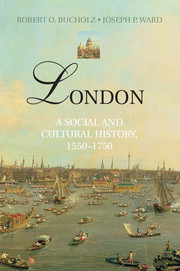Book contents
- Frontmatter
- Contents
- List of Illustrations and Maps
- List of Abbreviations and Conventions
- Acknowledgments
- Maps
- Introduction: London's Importance
- 1 London in 1550
- 2 The Socioeconomic Base
- 3 Royal and Civic London
- 4 Fine and Performed Arts
- 5 The Public Sphere and Popular Culture
- 6 The People on the Margins
- 7 Riot and Rebellion
- 8 Plague and Fire
- Conclusion: London in 1750
- Notes
- Further Reading
- Index
- Plate Section
8 - Plague and Fire
Published online by Cambridge University Press: 05 November 2012
- Frontmatter
- Contents
- List of Illustrations and Maps
- List of Abbreviations and Conventions
- Acknowledgments
- Maps
- Introduction: London's Importance
- 1 London in 1550
- 2 The Socioeconomic Base
- 3 Royal and Civic London
- 4 Fine and Performed Arts
- 5 The Public Sphere and Popular Culture
- 6 The People on the Margins
- 7 Riot and Rebellion
- 8 Plague and Fire
- Conclusion: London in 1750
- Notes
- Further Reading
- Index
- Plate Section
Summary
We have seen how early modern Londoners handled chronic, man-made urban problems: poverty, crime, riot, and political upheaval. Challenging as they were, none of these afflictions, not even the rebellions of the sixteenth and seventeenth centuries, fundamentally threatened London's livelihood, the viability of its population, or its very existence. We must now examine London in extremis. Between the spring of 1665 and the autumn of 1666, two catastrophes befell the city: the Great Plague (although there is some debate whether it really was the greatest plague) and the Great Fire. In fact, neither was unprecedented, except in size. What was Londoners’ experience of these disasters? How did they cope? Perhaps more important, how did they recover?
As we have seen, the 1660s were the decade of Restoration. Historians used to view the period as one of optimism and rational advance from the dark days of Civil War sectarian violence. It is true that these years saw an explosion of scientific progress, both symbolized and sustained by the foundation of the Royal Society, headquartered at Gresham College, in 1663. In addition, the English economy began a long-term recovery during this decade. National population growth began to slow down, and with it, the crippling inflation of the previous hundred years. The renewal of the Navigation Acts and the acquisition of New York in 1664 laid the groundwork for the Commercial Revolution that would make London the greatest port in Europe by the end of the century. Admittedly, only the most prescient could have anticipated the future benefits from these developments in the midst of a losing war, political tensions, and the natural disasters that characterized the middle of the decade, but a few scientists and statisticians, like John Graunt, Isaac Newton, and Sir William Petty, did try.
- Type
- Chapter
- Information
- LondonA Social and Cultural History, 1550–1750, pp. 309 - 331Publisher: Cambridge University PressPrint publication year: 2012



